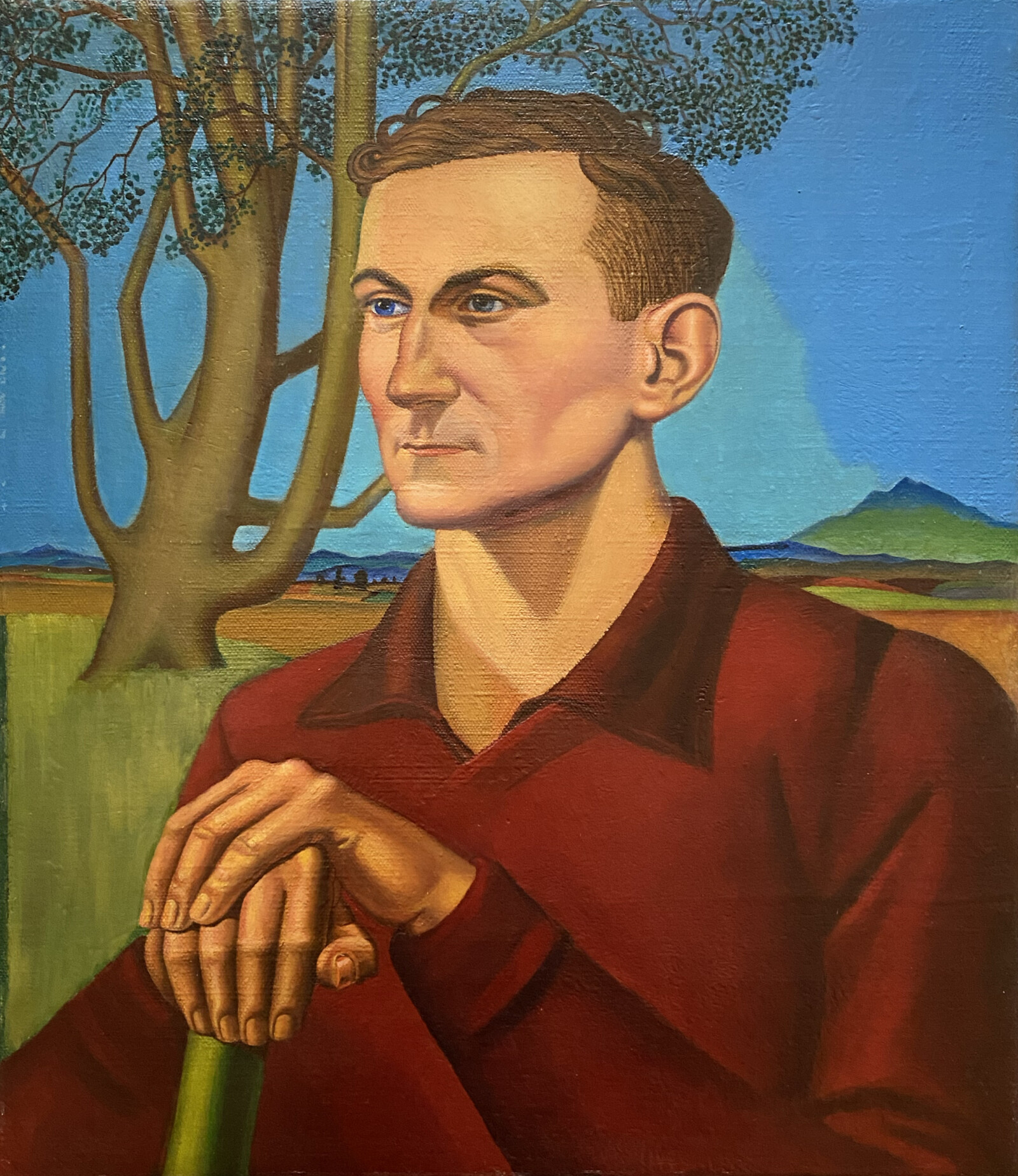BENSEMANN, Leo;
Harry Courtney Archer
c.1939
Oil on canvas
500 x 430mm (work); 550 x 475mm (frame)

From the 1930s to the 1950s, Ōtautahi was home to a progressive arts and culture group that Peter Simpson has termed ‘Bloomsbury South’. Among its most prominent members were artists Rita Angus and Leo Bensemann, who produced portraits of their friends. Harry Courtney Archer (1918–2002) was one such friend. He owned works by both artists, including Angus’s Mount Maud (1938) and Untitled (Hop Kilns, Motueka) (1941), and Bensemann’s Pass in Winter (1971), all now in the collection of Christchurch Art Gallery Te Puna o Waiwhetū.
It is not known whether Harry Courtney Archer was a commission or a gift. Simpson has dated the portrait to about 1939.[1] Until 1940, Archer worked at his family’s flour mill at Rangiora. The landscape ostensibly shows this location (Simpson suggests that the mountain is Maukatere Mount Grey), and it reflects Bensemann’s interest in Japanese art and Renaissance portraiture. Like Angus and Bensemann, Archer was a pacifist. Like other conscientious objectors, including Angus, he spent time at Pangatōtara and Riverside, in the Nelson region, during the Second World War.
Following the war, Archer travelled to China, where he worked alongside Rewi Alley at the Shandan Bailie School. The objective of the school was to impart useful knowledge to a poor community using a ‘half work, half study’ system. A short biography of Archer notes that he quickly became ‘a convert to the school’s philosophies and way of life. He was impressed by the students, admired Alley’s ideals and practical approach, and felt totally at ease in the strong family environment which had been created at the school.’
Political tumult made life in China difficult. Nevertheless, Archer persisted at the school for several years. In 1953, he made the decision to return to New Zealand, due to his father’s failing health. Following his father’s death in 1955, he took over the flour mill. He maintained ties to China, but Aotearoa was his base for the rest of his life. He lived at Rangiora with his male partner, Chen Tan, until his own death in 2002.
Bensemann’s portrait of Archer connects with several other paintings in the Fletcher Trust Collection. The most obviously resonant work is Angus’s Dona Nobis Pacem, a paean to pacifism that refers to Pangatōtara and Riverside. Colin McCahon’s Pangatōtara Landscape No. 1 is aesthetically distinct but connects to the same social and artistic milieu.
Harry Courtney Archer is a strong example of Bensemann’s work. The artist was always more at home as a draughtsman, but the picture shows a growing confidence with paint that places it in league with other major painted portraits, such as Albion Wright (1947), in the collection of Te Puna o Waiwhetū. Bensemann suffuses the work with symbolic content. Standing in a calm and fertile landscape, with his intelligent countenance and elegant hands resting on an unidentified tool, Archer becomes an emblem of peaceable life and labour.
[1] Peter Simpson, Fantastica: The World of Leo Bensemann (Tāmaki Makaurau: Auckland University Press, 2011), 56.
Exhibition History
Gathered Voices: Highlights from the Fletcher Trust Collection, The Suter Art Gallery Te Aratoi o Whakatū, Whakatū Nelson, 19 August to 12 November 2023 (toured)
References
Caroline Otto, Leo Bensemann: Portraits, Masks & Fantasy Figures (Whakatū Nelson: Nīkau Press, 2005), 80.
Peter Simpson, Fantastica: The World of Leo Bensemann (Tāmaki Makaurau: Auckland University Press, 2011), 56.
Provenance
2023–
Fletcher Trust Collection, purchased from Webb’s, Tāmaki Makaurau, 12 June 2023, Lot 42
2002–2023
Collection of Chen Tan, Rangiora, inherited from the subject, who was his partner
?–2002
Collection of the subject, Rangiora

